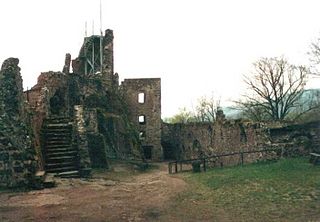
the Regenstein family, also Reinstein, was a Lower Saxon noble family, which was named after the eponymous Regenstein Castle near Blankenburg on the edge of the Harz Mountains of central Germany.

the Regenstein family, also Reinstein, was a Lower Saxon noble family, which was named after the eponymous Regenstein Castle near Blankenburg on the edge of the Harz Mountains of central Germany.
In 1162 Cunradus Comes de Regenstein (Conrad, Count of Regenstein), the son of Count Poppo I of Blankenburg from the House of Reginbodonen, was documented for the first time by name, thus establishing the line of Reinstein-Blankenburg. Heimburg came into their possession in the 14th century as a fief and founded the Younger Line of Reinstein(-Heimburg). Regenstein Castle (the line of Reinstein-Reinstein) was abandoned in the mid-15th century in favour of Blankenburg and Derenburg. The last male descendant of the noble family, John Ernest, Count of Regenstein, died in 1599. Parts of the county evolved into the Principality of Blankenburg.
The coat of arms of the comital line displays in silver a (black) red, six-tined antler. The later quartered shield shows also in silver (1:4) a black and in (2:3) a red six-tined antler. Helmet: crowned, right a black six-tined antler, left a red one of the same. The mantle is black and silver on the right and red and silver on the left.


Blankenburg (Harz) is a town and health resort in the district of Harz in Saxony-Anhalt, Germany, at the north foot of the Harz Mountains, 12 miles (19 km) southwest of Halberstadt.

Derenburg is a town in the district of Harz, in Saxony-Anhalt, Germany. Since 1 January 2010, it has been part of the Blankenburg am Harz municipality. Its population is 2,466 (2021).

The House of Henneberg was a medieval German comital family (Grafen) which from the 11th century onwards held large territories in the Duchy of Franconia. Their county was raised to a princely county in 1310.
The County of Regenstein was a mediaeval statelet of the Holy Roman Empire. It was ruled by the Saxon comital House of Regenstein, named after their residence at Regenstein Castle near Blankenburg north of the Harz mountain range.

The County of Blankenburg was a state of the Holy Roman Empire. Its capital was Blankenburg, it was located in and near the Harz mountains.

The County of Sponheim was an independent territory in the Holy Roman Empire that lasted from the 11th century until the early 19th century. The name comes from the municipality of Sponheim, where the counts had their original residence.

The County of Wernigerode was a state of the Holy Roman Empire which arose in the Harzgau region of the former Duchy of Saxony, at the northern foot of the Harz mountain range. The comital residence was at Wernigerode, now part of Saxony-Anhalt, Germany. The county was ruled by a branch of the House of Stolberg from 1429 until its mediatization to the Kingdom of Prussia in 1806. Nevertheless, the county remained in existence - with one short interruption - until the dissolution of the Kingdom of Prussia in 1918.

Countess Elisabeth of Regenstein-Blankenburg was Princess-Abbess of Quedlinburg. As such, she is numbered Elisabeth II.

Hohnstein Castle is one of the largest and best-preserved castle ruins in Germany and is located near Neustadt in the vicinity of Nordhausen in Thuringia.
Esico of Ballenstedt is the progenitor of the House of Ascania,. Esico was the count of Ballenstedt, and his possessions became the nucleus of the later Principality of Anhalt.

Regenstein Castle is a ruined castle that lies three kilometres north of Blankenburg in the German state of Saxony-Anhalt. It is a popular tourist destination where, each year, a knight's tournament and a garrison festival are held.

Great Blankenburg Castle was built on the limestone hill of Blankenstein in the town of Blankenburg in the district of Harz in the German state of Saxony-Anhalt. Nearby is the Little Castle with its Baroque garden, tea house and museum, the town wall, the pheasant garden, the castle park and the castle pond.

Poppo I of Blankenburg probably came from the House of Reginbodonen and was Count of Regenstein-Blankenburg in the Harz in central Germany.

Heimburg Castle, also called the Altenburg or Alteburg, is a ruined castle on an oval hilltop about 330 metres above sea level (NN) which is located just north of the Harz Mountains in central Germany. The ruins of this hilltop castle stand above the village of Heimburg in the borough of Blankenburg in the district of Harz in the state of Saxony-Anhalt. It is checkpoint no. 84 in the Harzer Wandernadel hiking network.

Hasserode Castle in the quarter of the same name in the town of Wernigerode am Harz was a medieval fortification whose site is near Hasserode station on the Harz Narrow Gauge Railways. Today there are no visible traces left of the castle.

The House of Stolberg is an old and large German dynasty of the former Holy Roman Empire's high aristocracy. Members of the family held the title of Fürst and Graf. They played a significant role in feudal Germany's history and, as a mediatized dynasty, enjoyed princely privileges until the collapse of the German Empire in 1918. The house has numerous branches.

Count Johann Reinhard I of Hanau-Lichtenberg ruled the county of Hanau-Lichtenberg from 1599 to 1625.

The Struvenburg was a medieval castle immediately east of Benzingerode, a village in the borough of Wernigerode in the district of Harz in the German state of Saxony-Anhalt. Today only a few earthworks remain. Very little is known about this castle. The name may be derived from the adjective struf = scrubby or rough.

The Arnstein family was a noble family from the Saxony-Anhalt region in Germany.